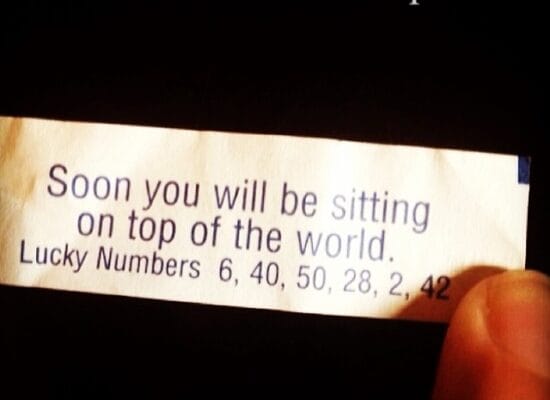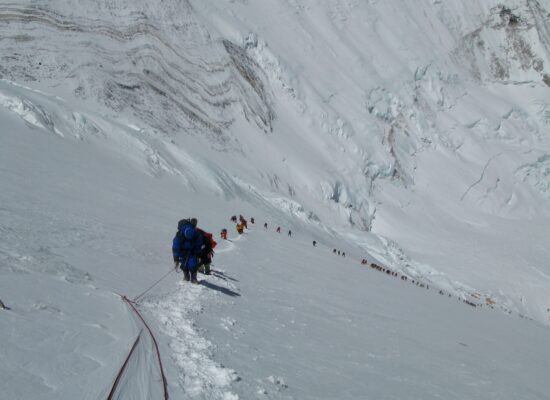This interview with Sandra Leduc is part of an ongoing series of interviews I do each season with Everest climbers. Not the famous, sponsored ones who get plenty of publicity but the regular people, who have full time jobs, full time families in many cases and climb for the love of climb. Please send me your suggestion for an interview. Now here’s Sandra:
There are many ways to train for climbing Mt. Everest but Sandra must have one of the most unique methods – two years posting in Afghanistan working with Canada’s Department of Foreign Affairs and International Trade (DFAIT). For the first year, she lived in a converted three-metre wide blast-proof metal shipping container with two tiny windows that didn’t open, so she should be comfortable in a spacious 3 person tent! 🙂
A world traveler, she has visited 60 countries, including places most tourists avoid — such as North Korea, Uzbekistan and Turkmenistan. She is on the 7 Summits path with climbs completed of Denali , Aconcagua, Elbrus and Kilimanjaro. This 34 year-old Canadian lawyer is working hard on behalf of Canadian solderers, Soldier On. She leaves for Nepal, Monday, April 2. Please meet Sandra
Q: You are on the 7 Summits track. What has been your most memorable climb thus far?
Denali in Alaska was my favourite. It was the longest. It was the hardest. And I met the most incredible people that I got to spend a significant amount of time with. When you know that you can carry 60lbs on your back uphill, while dragging a sled of the same weight for three weeks on end (without a shower), and that you can conquer a summit even though every step of the way has made you feel colder and more exhausted, you realize that you can do pretty much anything you set your mind to. For me and to this date, the feeling of achievement I got from summiting Denali has been unparalleled.
Q: Do you think working and living in Afghanistan will impact how you approach your Everest climb once you are there?
Absolutely, just as in many ways I think Denali was good preparation for living in Afghanistan. In Kabul, I spent two years living, eating, working and going to the gym with the same 50 people day in, day out. Though we sometimes had our differences, everyone learned to work together as a team and we all had a huge amount of respect for each other. We ultimately became very close, like a family. Living in a place like Afghanistan also extrinsically makes you better at adapting to unpredictable circumstances, and to just roll with the punches, so to speak. I’m already really excited to meet my other Everest team members as well as the whole climbing support team. I really see that being able to spend two months in close quarters with people from very different walks of life is a rare privilege and I think that a place like Afghanistan has taught me to appreciate having that kind of opportunity.
Q: Why did you select the South side?
The North and South side each have their pros and cons. With required multiple passes through the dreaded and dangerous Khumbu Icefall, the South side carries a higher degree of risk than the North side. But the highest camp on the North side is higher than the highest camp on the South side, meaning that you spent more time at higher altitude on the North side, upping the chances of exposure and frostbite. What sealed the deal for me though is that the North side is generally known to be colder than the South side. I’m slight and I wanted to minimize my frostbite risk as much as possible so warmer condition on the South side won me over. I also didn’t like the idea of driving to base camp, which is what you do on the North Side. I’ve trekked to Everest base camp on the South side before and the journey there is in itself an epic adventure. I wanted to do it again, this time with a better camera.
Q: You have some beautiful images on your website. What are your thoughts on capturing your Everest experience on film, umm card?
This is a tough one. Equipment weight is always a huge factor when climbing and for the average person, a simple point-and-shoot is more than enough. You absolutely don’t need an expensive camera to take beautiful pictures that are web-worthy and you shouldn’t be putting your life at risk to carry the extra weight of a heavy camera, especially if it’s not something you are used to doing. At the same time, my favourite hobby is photography. And mountain photography is my favourite kind of photography. Nothing makes me happier than being able to accurately convey the beauty of a place through a photo. As I’ll be spending a lot of time at base camp, I’ll be able to take my time thinking about and composing my shots – something that usually isn’t the norm when travelling. I knew relatively little about photography when I first travelled to Everest base case in 2000 and I wasn’t able get the shots I had in mind. So I have decided that this time, I will carry a (heavy) Nikon D800 at least up to base camp, a Canon G12 beyond that and a helmet cam GoPro Hero 2 for the requisite Khumbu icefall videos. It may not be the wisest choice, but it makes me happy.
Q: You are climbing to help wounded Canadian soldiers through sports. Please tell us about this effort.
I have been very fortunate in that my time in Afghanistan allowed me to better understand the work of our Canadian military. From the outside, I think it’s sometimes hard to understand and appreciate the level of dedication to country possessed by individuals who are servicing our country. Because I get so much personal satisfaction out of my choice athletic activity, I thought I could give back by helping soldiers who are wounded by supporting a charity that provides assistance through sports.
Soldier On is a relatively recent initiative that grew out of a grassroots idea in 2007 and it aims to use sport to improve the quality of life of current and former Canadian soldiers who are ill or injured. It has already played a significant role in helping and rehabilitating wounded soldiers and I especially like the fact that 100 percent of all donations go directly to the Soldier On Fund, with no portion going to administrative costs. Please visit their website for the charity.
Q: Any other thoughts for your followers this year?
I’ve been dreaming of climbing Everest for the past 12 years and the feeling of finally having a chance to attempt the summit is pretty amazing. Based on my experience so far, I can confirm to all those out there who don’t necessarily believe that everything is achievable or who haven’t yet taken the time to take stock of what it is they would really love to do in life, that once you decide to follow through on something, as crazy as it may seem, everything really does begin to magically fall into place. And when it does, you feel more alive than you have ever felt before.
Best of luck Sandra. We’ll be following along. You can learn more about Sandra at her website.
Climb On!
Alan
Memories are Everything




3 thoughts on “Everest 2012: Interview with Sandra Leduc”
Having had the honour and privilege of climbing with Sandra on Denali and “lending” her my Everest sherpa (Lakpa), you have to know that she is amazingly strong, good-hearted and deserving of a successful climb!
Another brilliant interview Alan! How fun to get to know the climbers as you so colorfully describe them and their passion for Everest! You make it all so exciting for us armchair enthusiasts! Bravo!!! An thank you……
Another great interview it does wonders for my imagination. Thank you Alan.
Comments are closed.